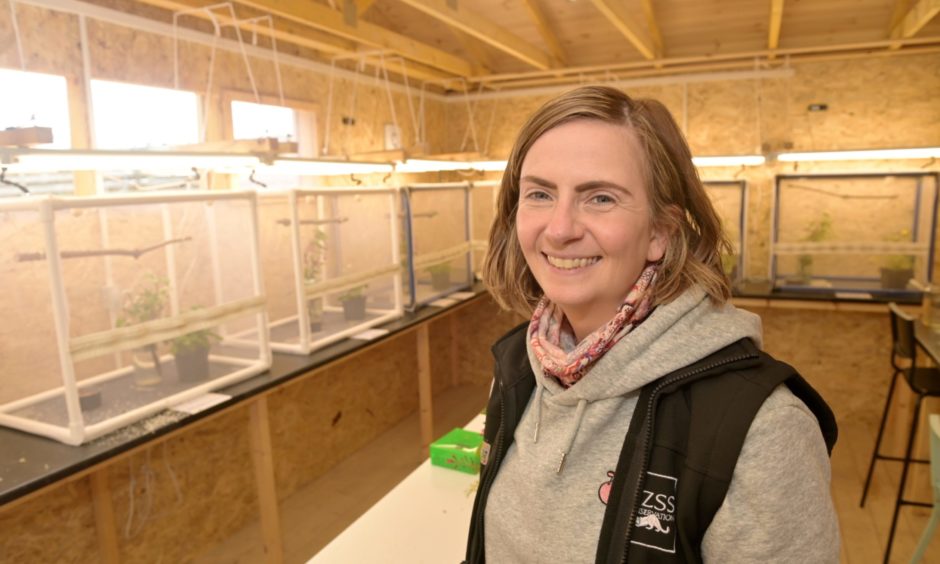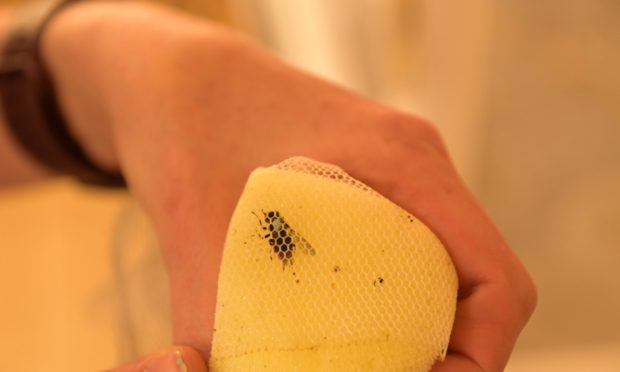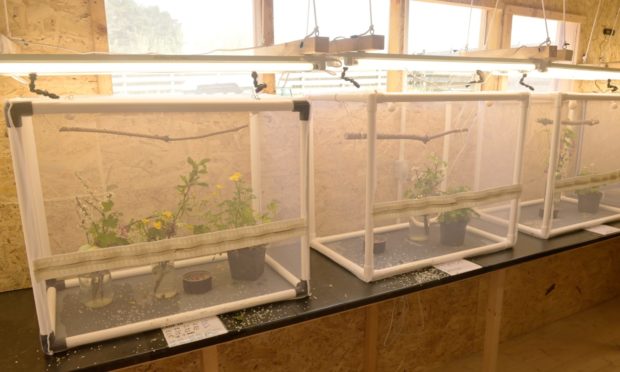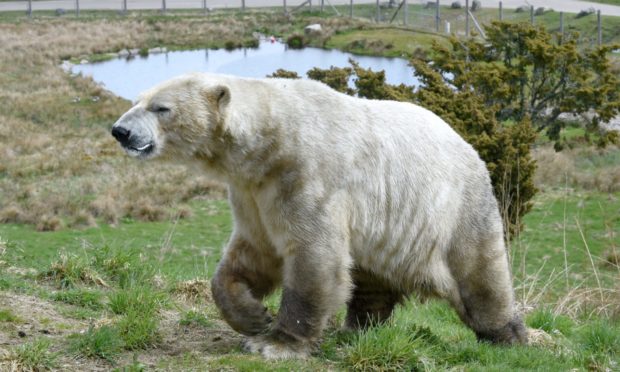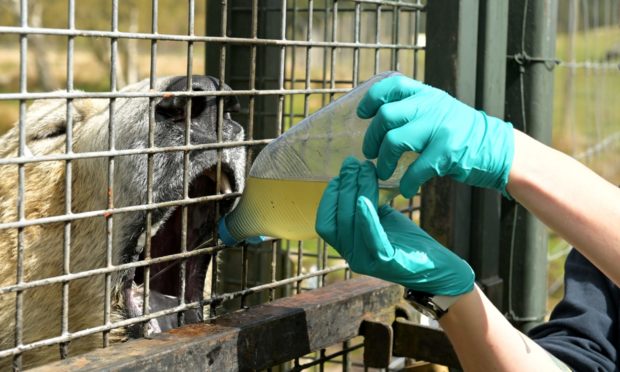With a steady hand and delicate touch, Dr Helen Taylor gives one of her growing number of charges a colourful identity.
Each one has a crucial role to play in the survival and development of a critically-endangered species.
Dr Taylor is overseeing the expansion of this small and largely-unknown but important invertebrate population.
The Press and Journal was given behind-the-scenes access to a new specially-built home at the Highland Wildlife Park for the pine hoverfly as the species heads for a record-breaking breeding season.
Sheds contain species’ largest population
They are confined to a forest in the Cairngorms and are so rare in the UK that no one has seen an adult pine hoverfly in the wild for more than eight years.
In fact, the two unassuming small wooden huts that make up the breeding programme’s base now contain more pine hoverflies than are known to exist in the wild in Britain.
Inside the newly-opened home Dr Taylor, the Royal Zoological Society of Scotland (RZSS) conservation programme manager, is surrounded by insects of various stages of development.
Some 60 adults and 80 pupae, entering the next stage of their life cycle on their way to becoming adults, are safeguarded in a collection of single-sex tanks.
She carefully gathers one female in a clear plastic container, before transferring it onto a small sponge protected by a see-through piece of cloth.
Then, like a model maker adding markings to a tiny kit plane, she takes non-toxic paint from a miniature pot and adds an almost microscopic distinguishing dot to the thorax of an insect 1-2cm long.
The process is an important part of the programme to ensure that mating males and females do not come from the same mother to maintain genetic diversity.
“We can tell males from females, but we can’t tell individual males or individual female apart.
“By putting on a tiny dot of paint helps keep track of where everyone is when they are in a cage together.”
This important conservation work with pine hoverflies and other species is currently going on away from the public eye in an area of the park not open to visitors.
But it is hoped that plans to build Scotland’s Wildlife Discovery Centre at the site will bring it more centre stage.
Prize draw aims to raise £50,000 for new centre
The £5.5million wildlife visitor and education centre is seen as having a pivotal role in conservation by inspiring up to 200,000 annual visitors and local people to protect nature and native wildlife.
As well as providing visitors to the park with a greater insight into the animals and environment, it will provide an outreach service to community and school groups.
So far more than £20,000 has been pledged. Entries are £5 and one winner will secure an after-hours, behind-the-scenes visit with David Field, CEO of the Royal Zoological Society of Scotland (RZSS) which runs the park and Edinburgh Zoo.
Entry closes on May 31.
The new centre will be a series of hubs spread across the existing wildlife park.
It is hoped work can start later this year or early 2022 with opening expected by 2023.
Dr Taylor said: “At the moment this is behind the scenes and part of the wildlife park visitors don’t get to see.
“Invertebrates are often forgotten as they are not a big fluffy charismatic species and we want more people to see the work we’re doing.
“The new discovery centre will give us a place to showcase this kind of work to the public and get them excited, while providing information about why invertebrates are so important for a healthy planet.
“They play numerous important roles in ecosystems. They pollenate plants, so if you like coffee or chocolate you want to look after invertebrates as they are plants that are pollenated by insects.
“They have other roles such as breaking down waste and form important parts of food chains.
You’ll notice when they’ve gone as things will stop working.”
Dr Helen Taylor
“As they start to disappear you start to see ecosystems fall apart as those roles are no longer being done.
“So you might not notice they are there, but you will notice when they’ve gone as things stop working and that’s not good for us or the planet.”
She added: “Invertebrates around the world are undergoing unprecedented decline at a really scary rate.
We can help people understand we have these extremely valuable species in the Highlands, which is a special places for a bunch of invertebrates like the pine hoverfly.”
Conservation projects at the wildlife park feed into RZSS’s work with National Museums Scotland to help develop the UK’s first national zoological biobank, which collects tissue, blood, serum and DNA from species whose numbers are under threat.
Scientists use the samples of a range of species, including those that are rare, endangered and extinct-in-the-wild, to help ensure their future survival.
The RZSS will provide laboratory space and an online searchable database which will be made available to researchers around the world.
Dr Taylor added: “The discovery centre is a great opportunity to talk to people coming to the park about the wider conservation work RZSS is doing at 23 projects in Scotland and around the world.
“The centre will be a gateway to explaining this to people and the massively important roles zoos play in conservation.”
At the other end of the scale from pine hoverflies, are the wildlife park’s polar bears which are among its most popular attractions.
New centre will allow interaction with nature
Senior carnivore keeper Judith Van De Voorde took time off feeding Walker to speak about the planned discovery centre and how it can help save larger endangered species, both native to the area and of a more exotic variety.
“It will provide more interaction with visitors and allow them to better interact with nature.
“We need that public engagement and hopefully it will encourage people to change their habits to create a better lifestyle for themselves which can help the planet.”
The park’s three polar bears are part of the European Endangered Species Programme and other threatened species being helped by conservation work at the reserve include Scottish wildcats and Przewalski’s horses.
A purpose-built centre to breed wildcats is taking shape at the park, while two Przewalski’s horse foals were born in April.
Ms Van De Voorde said Przewalski’s horses have been brought back from extinction in the wild following the success of conservation and reintroduction projects.
“It is a good example of why breeding programmes in zoos are so important.
“They were near extinction in the wild, but thanks to zoos conservation programmes we managed to get the population back up and release some of these animals into the wild.”
